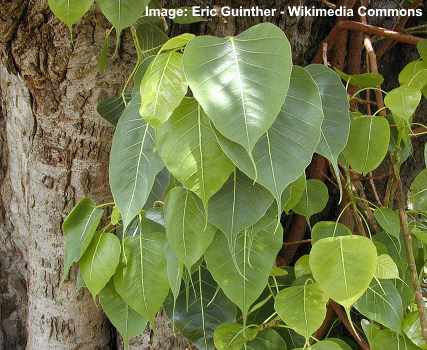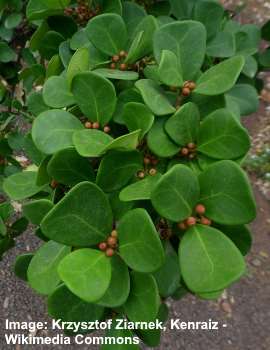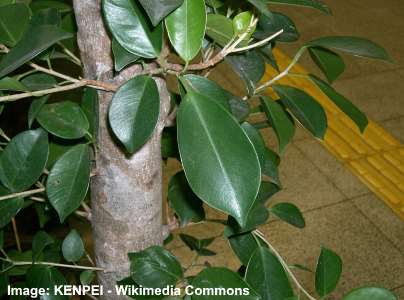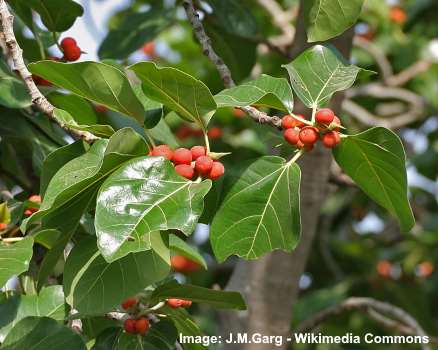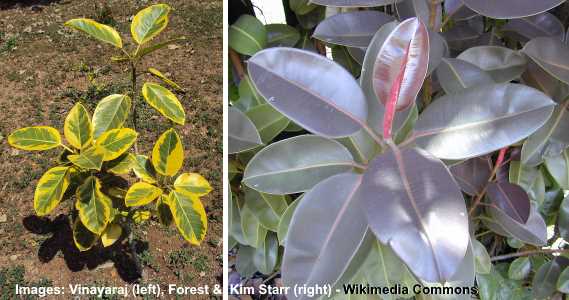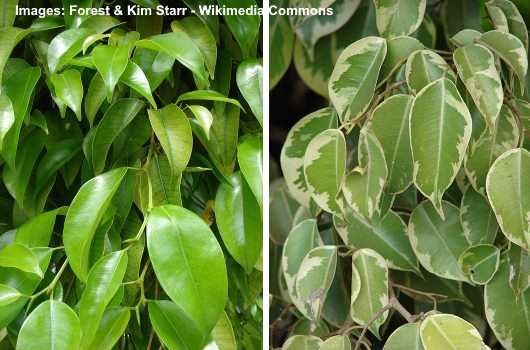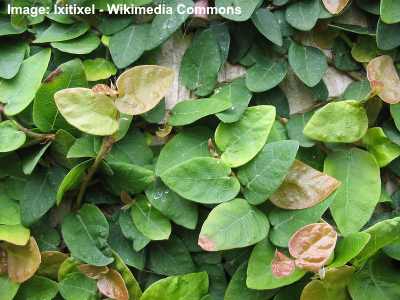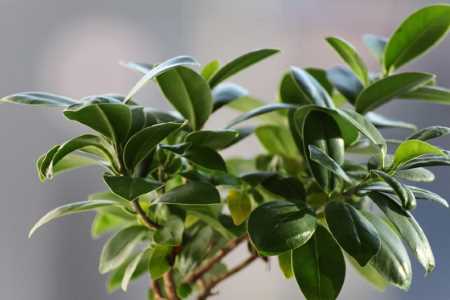Types of Ficus Trees: Outdoors and Indoors Ficus Plants (Including Pictures)
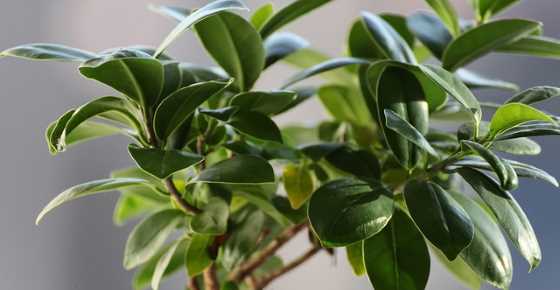
There are many types of ficus trees that make great houseplants and can also add greenery to your garden. In general, most varieties of ficus plants are easy to care for. Types of ficus trees include shrub-like plants, creeping vines, and woody trees.
As an outdoor tree, ficus plants can be large banyan trees, fig trees, or laurel trees. Indoor varieties of ficus trees are popular plants such as the Fiddle-leaf fig, rubber plant, Audrey ficus, and the Weeping fig. The reason why indoor ficus trees are so popular is that they are very versatile and suit a wide range of interior design needs.
In this article, you will learn about the many types of ficus trees that can add glossy foliage to your home or garden.
Types of Ficus Trees and Plants (With Pictures and Names)
There are about 850 species of plants in the ficus genus. These woody trees, vines, shrubs, and plants belong to the family Moraceae.
Generally, species of plants in the ficus genus grow in a wide variety of environments. Some types of ficus plant grow well outdoors in warm conditions. Other types of plants in the ficus genus are better suited as houseplants.
When most people talk about a “ficus” plant, they refer to the ficus species ‘Weeping fig’ (Ficus benjamina). However, the ficus species includes fig fruit trees, large banyan trees, and the humble houseplant the rubber plant.
Outdoor Ficus Trees
First, let’s look at some types of ficus trees that grow well outdoors. It is also good to remember that some of these varieties of ficus trees make good indoor plants.
Sacred Fig
The Sacred Fig (Ficus religiosa) species of ficus is a fast-growing type of tree that is well-suited to warm outdoor environments.
The distinctive feature of the Sacred fig is its heart-shaped leaves. With a proper care, this type of outdoor ficus tree can become a delightful ornamental tree in a garden or yard. Unlike many types of trees in the ficus genus, the Sacred fig enjoys full sunshine to grow well.
Regular pruning of this type of ficus tree in the winter and spring can help to keep its height to a manageable level.
Mistletoe Fig
The Mistletoe fig (Ficus deltoidea) is classed as a perennial variety of ficus that has thick waxy delta-shaped leaves.
This species of ficus shrub-like tree grows outdoors to a height of around 6.5 ft. (2 m). The Mistletoe fig has a spreading nature and you can use it to provide plenty of ground cover. However, to grow the Mistletoe fig outdoors, it needs to be in a warm environment.
This ficus tree also makes a good indoor houseplant. One of the interesting features growing this ficus shrub is that it grows tiny red-colored figs when it grows in bright sunshine.
Indian Laurel
Native to Asia and Australia, the Indian Laurel (Ficus microcarpa) is in the classification of ficus trees.
Planted as an outdoor ficus tree, the Indian Laurel needs to grow in subtropical and tropical climates. This type of ficus plant can be pruned to be an ornamental tree to provide plenty of shade in gardens.
Because the Indian Laurel needs a warm humid environment, cultivars of the Ficus microcarpa are popular as houseplants. The Indian Laurel is also a popular type of bonsai ficus miniature tree.
One interesting cultivar is the Ficus Emerald Green. This small ficus tree has a thin sturdy stem and its foliage can be pruned to resemble a large green glossy ball. The shape of this specimen ficus tree is why it is also referred to as a ‘lollipop.’
Common Fig
The Ficus carica is the common fig tree and can be grown as an ornamental plant in temperate climates.
Of course, fig trees that are native to Middle Eastern and Mediterranean countries are well-known for producing delicious fig fruits.
You can also grow cultivars of this ficus shrub tree even if you live in cooler climates. For example, ornamental ficus carica fig trees such as ‘Brown Turkey’ and ‘Chicago Hardy’ can grow in USDA hardiness zones 5 and 6.
The spreading habit of ficus fig trees also provides good shelter in your garden.
Indoor Ficus Trees and Plants (With Pictures and Names)
You can also choose tree-type ficus plants to grow indoors as houseplants. Let’s look at some of the most popular ficus houseplants.
Audrey Ficus
The Audrey ficus (Ficus benghalensis) is classified as a species of tree ficus that has luscious dark green velvety leaves and striking cream-colored veins.
Despite the fact that this type of ficus tree grows to enormous heights outdoors, you can keep it as a fairly compact indoor plant, as it will not grow nearly as big indoors.
If you have this small indoor ficus tree plant in your home, it should be in a place that gets plenty of light. Although this indoor ficus tree enjoys bright places, you should protect it from long periods of direct sunlight.
Being easy to care for is one of the reasons why Audrey ficus plant is a good choice as a houseplant. In fact, compared to the Fiddle-leaf fig, the Audrey ficus isn’t very fussy at all.
Fiddle-Leaf Fig
One of the popular types of indoor ficus trees is the Fiddle-Leaf fig (Ficus lyrata). This type of ficus has large green leaves and is a stunning indoor specimen plant.
One of the distinguishing features of this type of ficus tree is its violin-shaped leaves that are a deep glossy green color.
This is a slow-growing ficus tree that grows into an ornamental house plant. The long thin trunk can reach a height of up to 9.8 ft. (3 m) indoors. When the Fiddle-leaf grows outdoors it can reach heights of 50 ft. (15 m) and has a large bushy appearance.
Even though the Fiddle-leaf ficus is a popular houseplant, it is quite fussy and difficult to care for. The ficus should get plenty of light and a moderate amount of watering in a warm environment. However, it is sensitive to environmental changes and is best placed away from vents and drafts.
Narrow-Leafed Fig
The Narrow Leaf fig (Ficus maclellandii ‘Alii’) is another species of ficus tree that grows well indoors. This is also called the Banana fig, Alii fig, or Banana-leaf ficus.
This evergreen houseplant has long stems and the long leaves give the indoor tree a bushy appearance. The leaves grow between 3” and 5” (8 – 13 cm) and are long and narrow. These long drooping leaves make an attractive feature of this plant.
In the right conditions, expect the plant to grow up to 10 ft. (3 m) tall. However, with yearly pruning, you can keep its height much shorter.
The long spindly stems or trunks can be braided or pleated to form an attractive indoor ficus tree plant.
Compared to other types of indoor ficus plants, the Narrow Leaf fig is relatively easy to care for. It should be placed in indirect sunlight and the soil should be kept moist. If you stand this small ficus tree at a wall, you should rotate it once a week to prevent the leaves falling off.
Rubber Plant
The Rubber plant (Ficus elastica), or Rubber tree, is a very popular species of leafy indoor plant from the ficus genus. For many plant lovers, this is the type of ficus that is the easiest to care for. It is also one of the good luck plants according to the Feng Shui.
The Rubber plant has large attractive leaves which can grow up to 12” (30 cm) long. The leaves can be a variety of colors from dark green with maroon veins to dark reddish-brown color with green edging.
Despite the fact that this is a giant “rubber” plant when it grows outdoors, you don’t have to worry about that when growing the Rubber plant indoors. Usually, the Ficus elastica grows between 1 and 2 ft. (30 – 60 cm). So, this attractive indoors miniature ficus tree can be the centerpiece of a table or windowsill.
However, if you wish, you can allow the Rubber plant to grow as high as 8 ft. (2.4 m) indoors.
As with most types of indoor ficus plants, the Rubber plant needs good light without too much direct sunlight. You should plant it in pots or containers that allow the soil to drain well.
There are also various Ficus elastica cultivars that also make for beautiful ornamental houseplants. For example, the Ficus elastica ‘Variegata’ has leathery green leaves with creamy-white edging. The Ficus elastica ‘Black Prince’ has dark burgundy thick shiny leaves.
Weeping Fig
A popular ficus plant for indoors is the Weeping fig (Ficus benjamina) with its green shiny leaves and bushy appearance. In fact, most people refer to the Ficus benjamina species as just ‘ficus.’
Compared to other varieties of indoor and outdoor ficus trees, the Weeping fig has small leaves. These grow together to form a small shrub-like tree that is very decorative. The thin flexible trunks can also be trained to grow how you like them. One popular way to grow the Weeping fig is to braid its trunks.
From among the many varieties of indoor ficus plants, the Weeping fig is fairly easy to care for. Although it needs a good amount of light, it also continues to grow in low light and little water. As with many types of indoor ficus plants, moving its position and drafts can stress Weeping fig plant. To keep a Weeping fig healthy, you should water it once a week so that the soil is moist.
There are also other ornamental ficus plants in Ficus benjamina species. For example, the ‘Starlight’ Weeping fig is a cultivar of the ‘Weeping fig’ and is a bushy type of tree plant that has small white and green leaves. Another small type of ficus tree is the slow-growing ‘Too Little’ Weeping fig. This compact tree has very small leaves that are curled up.
Creeping Fig
The Creeping fig (Ficus pumila) is a type of woody creeping ficus vine that grows just as well indoors as it does outdoors.
The distinctive features of the Creeping fig are its small heart-shaped leaves and fast climbing growth. Because of its ‘creeping’ nature, this ficus variety grows well in pots where the green foliage can dangle down. So, creeping fig plants are good indoors in hanging baskets or on a shelf.
Indoors, you can also grow the Creeping fig up a moss pole.
One of the good things about this variety of ficus houseplant is that it’s extremely easy to grow. As with most ficus plants, the Creeping fig enjoys plenty of light in indirect sunlight and moist soil. However, the thin woody stems can withstand plenty of pruning.
This is also a hardy type of ficus plant to grow outdoors. Although it doesn’t tolerate frost well, it is hardy down to 34°F (1°C). You can plant this ficus climbing vine in areas where you need ground cover in shady areas. Or, you can train it to grow up walls or trellises like types of ivy.
Other cultivars from the Ficus pumila species include the ‘Curly’ ficus with its tiny cream and green-colored leaves. Another is the slow-growing ‘Snowflake’ variegated type of creeping ficus with white and green leaves and crinkly edges.
Ficus Daniella
The Ficus Daniella (also known as Ficus Moclame) is another variety of ficus that adapts well as an indoor houseplant. This type of ficus has thick waxy leaves and in a nice oval shape.
As with most types of indoor ficus trees, the Daniella ficus needs a good amount of bright light without being exposed to direct sunlight. To keep the environment humid enough, regular misting helps the ficus plant to grow well. Also, changes to its position may cause the leaves to fall off.
Ficus Tree Plant Care
In general, it’s fairly easy to provide the right conditions for your ficus trees to thrive. Here are some of the best ways to care for your ficus plants.
How to care for a ficus plant indoors
The most important factors to care for your indoor ficus trees are the light, soil, and pruning.
Soil. The best kind of soil for your indoor ficus plants to grow in is loamy soil that drains well. There should be enough holes in the pot to allow excess water to drain.
Light. Nearly all indoor plants from the Ficus genus require plenty of light. However, direct sunlight can burn ficus leaves and cause them to fall off. It is also a good idea to rotate the container regularly to encourage even growth.
Water. During warm months, you should water your ficus once a week. One sign that you are over-watering your ficus houseplant is if the leaves turn yellow. You can also increase humidity by misting the leaves regularly.
Pruning. The best times to prune your ficus tree indoors is in spring and winter. This can help to keep your growing indoor tree to a reasonable height. Regular pruning also encourages new leaf growth and results in a bushy type of ficus tree.
Outdoor ficus plant tree care
In their natural setting, ficus trees can grow to a great height and their wide spread can provide a lot of shade. Ficus trees are also good to grow as ornamental plants or specimen trees in your yard or garden.
Because ficus trees are native to tropical and warm climates, they will only thrive in USDA hardiness zones 10 and 11. Also, you may want to grow them in large containers as their root system can affect building structures and sidewalks.
Where to plant a ficus tree outdoors. The best place for an outdoors ficus tree is sheltered from the wind and direct sunlight.
Soil and watering. As with indoor ficus plants, a ficus tree growing outdoors needs loamy soil that drains well. So, if planting in a container, make sure that water drains freely from the pot. Planting in a container will also help to contain its height.
Pruning. The only reason to trim a ficus tree that grows outdoors is to encourage new growth or to create an attractive hedge.
Related articles:
- 15 Small or Dwarf Evergreen Trees For Your Garden
- Types of Shrubs: 18 Different Types of Bushes to Grow in Your Yard
- Lilac Bush: Facts, How to Grow It, Care Tips and More

